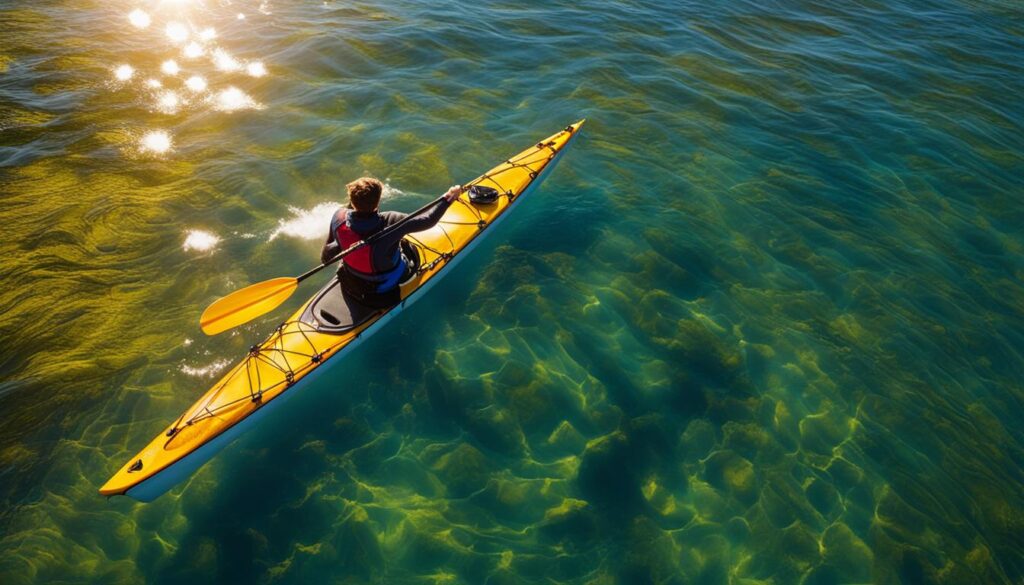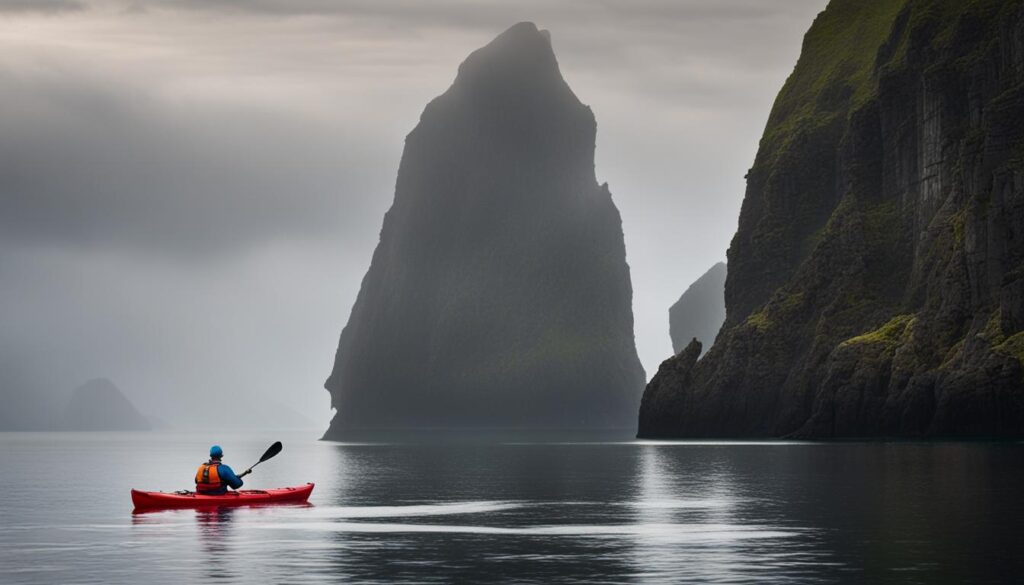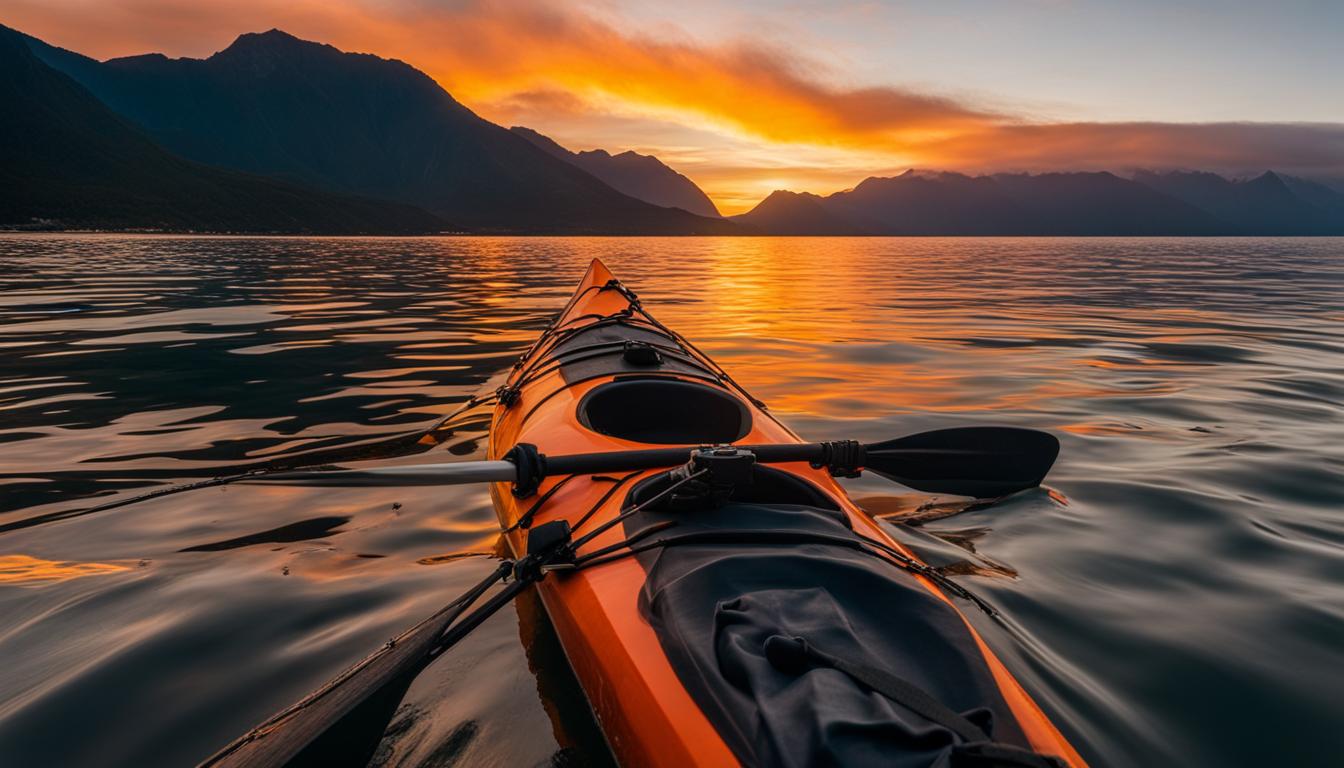Sea kayaking offers incredible opportunities for capturing stunning photos. With the right tips and techniques, you can master the art of kayaking photography and document your kayak adventures in a memorable way. From choosing the right gear to composing your shots, we will guide you through the process of capturing breathtaking photos on your sea kayaking journey.
Key Takeaways:
- Invest in a waterproof camera or use a waterproof housing for your existing camera to protect it from water damage.
- Consider using a DSLR camera with a telephoto lens for capturing wildlife or a compact camera for easier handling on the kayak.
- Experiment with different angles and perspectives to capture the essence of your kayak adventure.
- Include elements like the bow of your kayak, fellow paddlers, and the surrounding environment to add visual interest to your shots.
- Practice patience and silence to avoid disturbing wildlife while capturing their photos.
Kayaking Photography Gear: What You Need to Know
When it comes to kayaking photography, having the right gear is crucial for capturing stunning photos on your sea kayaking journey. The unpredictable nature of water and the potential for splashes require equipment that is durable, waterproof, and easy to handle.
First and foremost, invest in a waterproof camera or consider using a waterproof housing for your existing camera. This will protect your equipment from water damage and allow you to confidently shoot in wet conditions. With a waterproof camera, you won’t have to worry about accidents or missed photo opportunities.
When choosing a camera, consider factors such as image quality, size, and ease of use. A DSLR camera with a telephoto lens can be ideal for capturing wildlife or distant scenery, providing you with detailed and high-resolution images. However, if you prefer ease of handling on a kayak, a compact camera might be a better option. These cameras are lightweight, portable, and often have built-in waterproof features.
Composition Tips for Kayaking Photography
When it comes to kayaking photography, composition is key to capturing memorable moments and creating stunning snapshots of your kayak adventures. By experimenting with different angles, perspectives, and elements, you can elevate your photos to the next level. Here are some composition tips to help you take your kayaking photography to new heights:
1. Capture the Essence of Your Kayak Adventure
When framing your shots, aim to convey the excitement and beauty of your kayak journey. Include elements that showcase the experience, such as the bow of your kayak, fellow paddlers, and the stunning natural surroundings. By doing so, you can transport viewers into the scene and make them feel like they are part of your adventure.
2. Pay Attention to Details and Close-ups
Don’t be afraid to get up close and personal with your subject matter. Whether it’s capturing water droplets, plants, or wildlife, focusing on the details can add depth and visual interest to your photos. Look for unique textures, patterns, or colors that can tell a captivating story and evoke emotions in your audience.
3. Follow the Rule of Thirds and Use Leading Lines
The rule of thirds is a fundamental principle in photography that involves dividing your frame into a grid of nine equal parts. Place key elements of your composition along these gridlines or at their intersections to create a balanced and visually pleasing image. Additionally, incorporating leading lines, such as the shoreline or the flow of water, can guide the viewer’s eye through the photo and create a sense of depth and movement.
Remember, capturing kayak adventures through photography is not only about technical aspects but also about expressing your unique perspective and vision. So, don’t be afraid to experiment, try different compositions, and let your creativity shine through in every shot.
| Composition Tips for Kayaking Photography | |
|---|---|
| 1. Capture the Essence of Your Kayak Adventure | |
| Include elements that showcase the experience, such as the bow of your kayak, fellow paddlers, and the stunning natural surroundings. | |
| 2. Pay Attention to Details and Close-ups | |
| Focusing on the details can add depth and visual interest to your photos. | |
| 3. Follow the Rule of Thirds and Use Leading Lines | |
| Place key elements along the gridlines and incorporate leading lines to guide the viewer’s eye and create depth. |

“Photography takes an instant out of time, altering life by holding it still.” – Dorothea Lange
Kayaking Photography: Tips for Photographing Wildlife While Kayaking
One of the most thrilling aspects of sea kayaking is the opportunity to encounter wildlife up close. Whether it’s dolphins, seals, or majestic birds, capturing these incredible moments through photography can be a truly rewarding experience. To help you make the most of these encounters, here are some tips for wildlife photography while kayaking.
1. Respect the Wildlife
When photographing wildlife while kayaking, it’s important to remember that you are a guest in their natural habitat. Respect their space and avoid disturbing or causing stress to the animals. Keep a safe distance and observe their behavior from afar. This not only ensures their well-being but also allows for more authentic and natural shots.
2. Use a Telephoto Lens
To capture detailed shots of wildlife without getting too close, it’s recommended to use a telephoto lens. This type of lens allows you to zoom in and get sharp, close-up shots from a distance. With a telephoto lens, you can capture the intricate patterns on a bird’s feathers or the playful expression on a seal’s face, while maintaining a safe distance.
3. Be Prepared and Patient
Wildlife photography requires patience and preparation. Keep your camera at the ready and be prepared to take quick shots when an opportunity arises. Wildlife can be unpredictable, so it’s essential to be patient and wait for the perfect moment. Use silent shooting mode if available to minimize any noise that could startle the animals.
4. Capture Behavioral Moments
When photographing wildlife, try to capture their unique behaviors and interactions. Look for moments that tell a story or evoke a sense of emotion. Maybe it’s a mother bird feeding her chicks or a seal playing in the water. These behavioral shots add depth and interest to your wildlife photographs.
Remember, wildlife photography while kayaking is about capturing the beauty of nature and preserving these precious moments. By respecting the wildlife, using the right gear, and practicing patience, you can capture stunning photographs that tell a story of the incredible encounters you experience on your sea kayaking journey.
Best Locations for Kayaking Photography in the United States
If you’re a kayaking enthusiast and a photography lover, you’re in for a treat in the United States. With its diverse landscapes and breathtaking waterways, the US offers a plethora of stunning locations for capturing memorable kayak photos. Whether you’re seeking dramatic coastal scenery or unique ecosystems teeming with wildlife, there’s a kayaking spot that will fulfill your photography dreams. Here are some top locations to consider:
California
The coastal areas of California provide a perfect backdrop for kayaking photography. From the iconic rock formations of Big Sur to the picturesque beaches of Santa Cruz, you’ll find endless opportunities to capture the beauty of the Pacific Ocean. Explore places like Mendocino County, Channel Islands National Park, or the stunning Monterey Bay, where you can witness the spectacle of migrating whales.
Alaska
If you’re looking for truly wild and untouched landscapes, Alaska is a must-visit destination. Paddle through the serene waters of Glacier Bay National Park and Preserve, where towering glaciers meet the sea. Capture the grandeur of Denali National Park or the stunning fjords of Kenai Fjords National Park. Keep your camera ready for wildlife encounters, including bears, eagles, and seals.
Maine
Maine is a gem for sea kayaking enthusiasts, offering rugged coastlines, picturesque lighthouses, and charming fishing villages. Explore Acadia National Park, where you can capture stunning views of the rocky shoreline and Mount Desert Island. Venture into the quiet waters of the Gulf of Maine, where you may encounter seals, porpoises, and even the occasional whale.
These are just a few examples of the amazing kayaking photography locations in the United States. So grab your camera, hop in a kayak, and prepare to be amazed by the beauty that awaits you.

Tips for Taking Photos in Challenging Conditions
Capturing stunning photos while kayaking can be a thrilling and rewarding experience. However, it often comes with its fair share of challenges. From dealing with low light situations to rough waters, here are some valuable tips to help you take amazing photos in challenging conditions.
Photography Tips on the Water
When you’re out on the water, stability is key to getting clear and sharp photos. Consider using a tripod or a stable surface like a kayak deck to minimize camera shake. This will help you avoid blurry images, especially in rough waters. If you don’t have a tripod, try bracing yourself against the kayak or using your body as support to steady the camera.
In addition to stability, adjusting your camera settings is crucial for capturing great photos on the water. In low light conditions, such as during sunrise or sunset, increase your ISO setting to allow more light into the camera sensor. This will help you maintain a faster shutter speed and avoid motion blur.
Kayaking Photography in Low Light
- Use a tripod or stable surface to minimize camera shake
- Adjust your ISO setting for better exposure in low light conditions
- Experiment with longer exposures to capture the beauty of water movement
Additionally, consider experimenting with longer exposures to capture motion in the water. This technique can create stunning effects, such as silky smooth waterfalls or flowing waves. Just remember to use a tripod or stable surface to keep the camera steady during longer exposure times.
Capturing Photos in Rough Waters
- Ensure your camera is securely attached to your body or kayak
- Protect your camera from water spray with a waterproof cover
- Shoot in burst mode to capture action shots effectively
When photographing in rough waters, it’s essential to take precautions to protect your equipment. Secure your camera and paddle with a leash or strap to prevent accidental drops. Use a waterproof cover or case to shield your camera from water spray and splashes.
Lastly, shooting in burst mode can be beneficial for capturing action shots in rough waters. This feature allows you to take multiple photos in quick succession, increasing your chances of getting the perfect shot amidst the movement of the water.
By implementing these tips, you’ll be better prepared to overcome the challenges of taking photos in challenging conditions while kayaking. Remember to prioritize your safety and enjoy the process of capturing stunning images of your kayaking adventures.
Conclusion
Capturing stunning photos while kayaking is an exhilarating and rewarding experience. By following these sea kayaking photo tips, you can enhance your skills and create remarkable memories of your kayak moments.
Investing in the right gear is crucial when taking photos while kayaking. Ensure you have a waterproof camera or a waterproof housing to protect your equipment from water damage. Consider using a DSLR camera with a telephoto lens for capturing wildlife or a compact camera for easier handling on the kayak. Don’t forget to pack essentials like lens cleaning cloths and lens filters to enhance your shots.
Remember to pay attention to composition while capturing your kayak adventures. Experiment with different angles and perspectives to add visual interest to your photos. Incorporate elements like the bow of your kayak, fellow paddlers, and the surrounding environment to tell a captivating story. Utilize the rule of thirds and leading lines to guide the viewer’s eye through the photo.
Lastly, immerse yourself in the beauty of nature while documenting your kayak moments. Explore various locations in the United States that offer picturesque landscapes and abundant wildlife. Enjoy the process, prioritize safety, and capture the essence of your sea kayaking journey with passion and creativity. Happy photographing!
FAQ
What kind of camera should I use for kayaking photography?
It is recommended to use a waterproof camera or a camera with a waterproof housing to protect it from water damage while kayaking.
What type of lens should I use for wildlife photography while kayaking?
A telephoto lens is recommended for capturing detailed shots of wildlife without getting too close.
How can I compose my kayak photos to make them more visually appealing?
Experiment with different angles and perspectives, include elements like the bow of your kayak and the surrounding environment, and pay attention to the rule of thirds and leading lines.
How should I approach and photograph wildlife while kayaking?
Practice patience and silence, use a telephoto lens or zoom function to capture detailed shots, be aware of your surroundings, and learn about the behavior of the wildlife you encounter.
What are some recommended locations for kayaking photography in the United States?
Coastal areas in California, Alaska, and Maine offer dramatic landscapes and abundant wildlife. The Florida Everglades and the Great Lakes provide unique ecosystems and diverse species. Iconic waterways like the Colorado River and the Boundary Waters in Minnesota also offer stunning photo opportunities.
How can I take photos in challenging conditions while kayaking?
Learn how to stabilize your camera and adjust your settings for different lighting and water conditions. Use a tripod or stable surface, protect your equipment from water spray, and consider shooting in burst mode for action shots.





